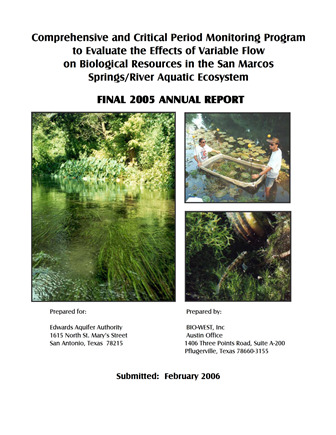Comprehensive and Critical Period Monitoring Program to Evaluate the Effects of Variable Flow on Biological Resources in the San Marcos Springs/River Aquatic Ecosystem Final 2005 Annual Report

| Author | BIO-WEST, Inc |
| Year | 2006 |
| Description | Annual report for 2005 on biota study of San Marcos Springs/River |
| Publisher | BIO-WEST Inc |
| Location | San Marcos Springs/River |
| Summary |
|
The purpose of this report is to document the results of all aquatic ecosystem monitoring conducted in 2005 at San Marcos Springs located in San Marcos, Texas. The monitoring and report preparation was performed by BIO-WEST, Inc. Pflugerville, Texas. [Excerpted from Executive Summary] Though water quality readings were not taken (except during drop net samples) in the San Marcos River in 2005, the biological community flourished as in previous years. … For the fountain darter (Etheostoma fonticola), habitat use is largely influenced by aquatic vegetation and assessments of habitat availability were conducted by mapping this vegetation during each sampling event. Vegetation in the I-35 reach had substantially more change in communities than the City Park and Spring Lake Dam reaches, as a result of the high flows in late 2004. Cabomba was reduced drastically in spring 2005 in the I-35 reach, but recovered somewhat by fall 2005. This vegetation type is important because it provides the highest-quality fountain darter habitat (of those sampled quantitatively) in the San Marcos River, and this reach is the only place where it is found (of the reaches sampled). … In contrast to previous years, total coverage of Texas wild-rice in the San Marcos River decreased from 2004 to 2005. … The size-class distribution for fountain darters collected by drop nets from the San Marcos Springs/River ecosystem in 2005 is typical of a healthy fish assemblage. … Only two giant ramshorn snails (Marisa cornuarietis) were found 2005 in the San Marcos River. However, because of the potential for a rapid population increase and the impact that this exotic species can have under heavier densities, close monitoring should continue. The gill parasite that has been reported to infect the fountain darter in the Comal system was not visually evident in fountain darters collected from the San Marcos system in 2005. … Salamander densities were highly variable between fall and spring in 2005, with fall having higher densities at 2 of 3 sites. Filamentous algae remained abundant throughout 2005 and each sampling event conducted in the Hotel Reach and the deep site in Spring Lake required clearing the algae prior to sampling efforts. … Though the comprehensive portion of the study has been reduced to two annual samples (plus a limited summer effort), it is still adequate to maintain a continuous record of conditions. That is vital knowledge since antecedent conditions influence community-level response to reduced discharge conditions. Sampling only during a low-flow event will not provide the necessary context to adequately assess changes that occur during such conditions. |
Search for Documents
Advance Search
Explore EAA's Scientific Reports
- All Reports
- Precipitation
- Overview Studies
- Modeling
- Hydrology and Hydrogeology
- History
- Groundwater Recharge, Recharge Zone
- Groundwater Movement
- Geomorphology and Caves
- Weather Modification
- Geology
- Water Use and Conservation
- Geochemistry
- Water Resources Planning and Management
- Floods and Drought
- Water Quality
- Climatology
- Surface Water / Groundwater Relationship
- Biology
- Springs, Groundwater Discharge
- Archaeology
- RZ Protection
- Aquifer Levels
- Remote Sensing
